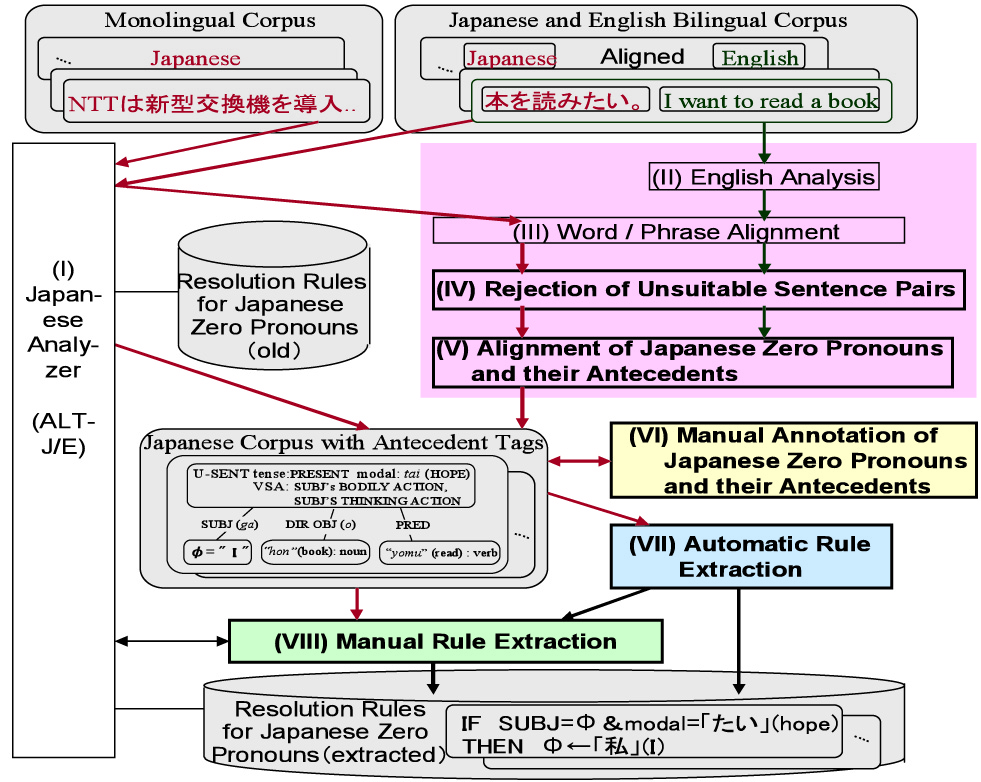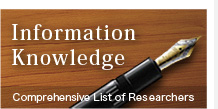Comprehensive List of Researchers "Information Knowledge"
Department of Media Science
- Name
- NAKAIWA, Hiromi
- Group
- Media Expression Group
- Title
- Visiting Professor
- Degree
- Dr. of Engineering
- Research Field
- Natural Language Understanding / Semantic Lexicon / Machine Translation

Current Research
Understanding Natural Language in Context
OUTLINEWhen a human tries to understand a sentence, he or she examines not only the sentence itself but also the context surrounding the sentence. Our research goal is to realize a computer that can understand sentences by taking into account their context as a human does. We are mainly doing research on how to resolve anaphoric expressions such as ellipsis (zero pronouns) and pronouns as well as automatic extraction of rules for anaphora resolution of zero pronouns. For this research, we are also investigating a mechanism for automatically annotating zero pronouns and their antecedents in text and designing verbal semantic attributes as a condition for anaphora resolution to avoid an explosion of resolution rules. We are also investigating machine translation methods for translating Japanese anaphoric expressions into English.
TOPICS
- Natural Language Understanding
In natural languages, elements that can be easily deduced by a reader are frequently omitted from expressions in texts. This phenomenon causes considerable problems in natural language processing systems. In particular, the subject and object are often omitted in Japanese, whereas they are normally obligatory in English. In Japanese-to-English machine translation systems, therefore, it is necessary to identify case elements omitted from the original Japanese (zero pronouns) for their accurate translation into English expressions. We are investigating a technique for anaphora resolution of Japanese zero pronouns that is suitable for applications using a practical machine translation system with an unlimited translation target area. This method employs anaphora resolution conditions specially designed for zero pronouns based on the location of their antecedents : antecedents in the same sentence (intra-sentential anaphora), antecedents in a different sentence of the document (inter-sentential anaphora), and antecedents that do not explicitly exist in documents (deictic anaphora). Furthermore, we are also investigating a method for automatically extracting rules of Japanese zero-pronoun resolution from Japanese and English aligned sentence pairs. This method takes into account the practical situation for making resolution rules of zero pronouns in specific domain texts. Here, the types of usable corpora (monolingual and/or bilingual) for examining the extraction of resolution rules change depending on the type of NLP system using extracted resolution rules.
- Semantic Lexicon
Natural language understanding, including Japanese zero-pronoun resolution, commonly requires an enormous volume of knowledge of word meaning that can be used to determine the semantic relationship between one sentence and another. To avoid an explosion in the volume of knowledge, we propose a system of 107 verbal semantic attributes of Japanese that considers both dynamic characteristics and the relationship of verbs to cases such as subjects and objects.
- Machine Translation
Machine translation also requires discourse analysis for selecting translation candidates suitable for a specific discourse. We are investigating a method for translating anaphoric expressions such as zero pronouns in Japanese into natural English based on their context.
FUTURE WORK

Figure : Extraction of Resolution Rules for Zero Pronouns from Aligned Sentence Paris
Career
- Hiromi Nakaiwa received the M. Eng. and Dr. Eng. in Electrical Engineering from Nagoya University in 1987 and 2002, respectively.
- He joined the Nippon Telegraph and Telephone Company (NTT) in 1987.
- Since 2008, he has been an Executive Manager of NTT Communication Science Labs.
- Since 2009, he has served concurrently as a Visiting. Prof. at Nagoya University.
- From 1995 to 1996, he was a visiting researcher at UMIST, Manchester, UK.
- From 2000 to 2002, he was a department head of ATR Spoken Language Translation Research Laboratories.
Academic Societies
- IPSJ
- JSAI
- ANLP
- ACL
Publications
- Automatic Extraction of Rules for Anaphora Resolution of Japanese Zero Pronouns in Japanese-to-English Machine Translation from Aligned Sentence Pairs, Machine Translation, 14 (3-4), 247-279, Kluwer Academic Publ. (2001).
- A System of Verbal Semantic Attributes Focused on the Syntactic Correspondence between Japanese and English. Proc. Of COLING-94, 672-678 (1994).
- Extracting representative arguments from dictionaries for resolving zero pronouns, Proc. of Machine Translation Summit X, Phuket, Thailand, 3-10 (2005).








